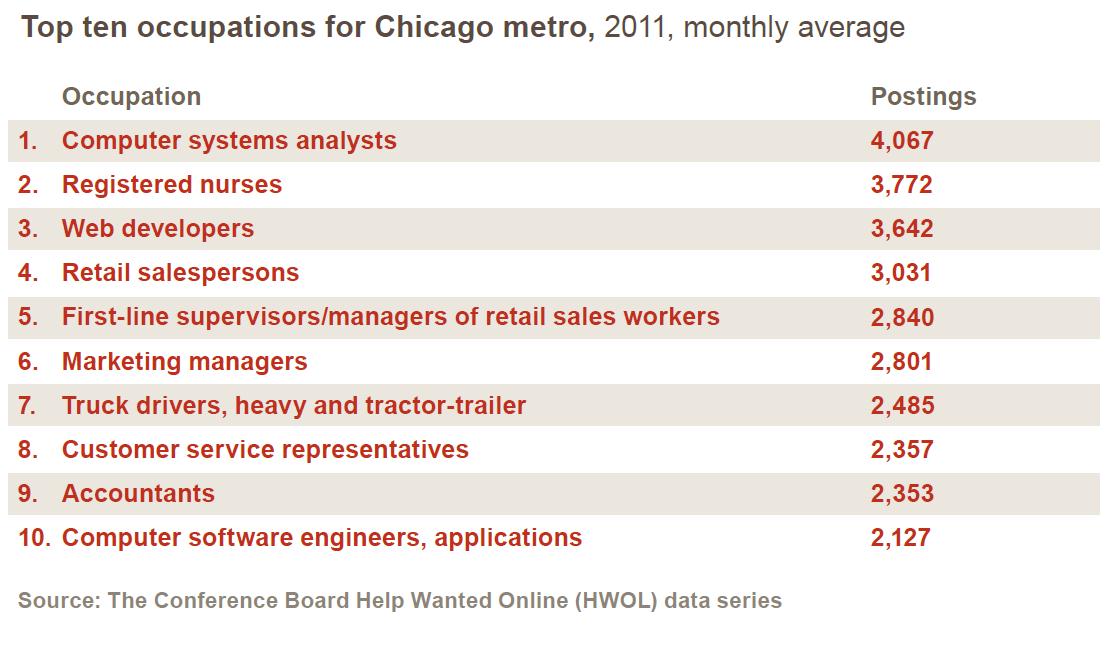On-line job boards – which connect job seekers to employers – now account for one in five of all new hires. While these boards connect job seekers to more open positions and give companies access to more qualified applicants, they have also emerged as a valuable research tool for information about the labor market. The July 2012 edition of the Illinois Innovation Index looks at the largest job boards in the Chicago region to provide current metrics about regional labor supply and demand.
On-line job listings don't account for all jobs and job seekers. Industries such as construction, agriculture, or manufacturing seldom use on-line job boards, and on-line listings do not reflect potential job seekers who lack internet access. (To learn more, check out the earlier Illinois Innovation Index for May 2012, which focused on broadband access and its support of innovation in Illinois.) With these caveats in mind, on-line job listings can still capture some larger trends in the labor market, including the experience and skills of prospective employees, what types of occupations are more available, and what industries are hiring.
High-Demand Occupations
According to the July index, the Chicago metropolitan statistical area (MSA, which includes parts of northwestern Indiana and southeastern Wisconsin) had about 125,000 on-line postings each month in 2011. That data show that these postings were a mix of innovative and more traditional occupations. The top occupation for the Chicago MSA region by number of postings was computer systems analyst. Web developers, computer software engineers, computer support specialists, and network and computer systems administrators all were in the top 15 occupations, highlighting the demand for innovative technology positions.
In addition to the availability of positions in innovative industries such as information technology (IT), on-line jobs postings in the Chicago MSA region also indicate the demand for more traditional occupations such as nurses, retail salespersons, truck drivers, and customer service representatives (as seen in the table below). This range of postings speaks to diversity of the regional economy: according to the Index, no industry in the Chicago MSA region employs more than 13 percent of the 4.29 million workers here.

In addition to providing metrics on job postings by occupation, the July Index looks at job postings by company. One important finding was that two staffing firms focusing on IT and healthcare workers -- Allegis and Kforce -- were in the top ten of all companies by job postings. The Index concludes that due to lingering economic uncertainty, many companies are relying more deeply on outside staffing companies for access to the labor force.
Regional Labor Pool
The Illinois Innovation Index analysis on labor demand is complemented by a focus on the supply of workers in the region. As the Index shows, about half of all of the region's labor supply are using on-line job boards in three types of occupations: office/administration (23 percent), management (21 percent), and computer and mathematical (10 percent). The Index also notes that the regional workforce is well-educated, with half of all job seekers using a job board in 2011 holding at least a bachelor's degree.
On-line job postings can also be used to compare the experience level required by job listings to the experience of applicants. The data from the Index suggest that the Chicago MSA region may have a labor market experience gap. As the chart below shows, in all positions requiring seven or less years of experience there are more job postings than new resumes. This is particularly noticeable in the two to five year segment of the market. In contrast, new resumes greatly outnumber regional job postings in positions requiring more than seven years of experience, becoming more pronounced as the years of work experience increase.

Though they do not capture all components of the labor market, the metrics provided in this month's Illinois Innovation Index provide valuable insights into regional trends. Key takeaway points from the Index for policymakers include the diversity of the regional economy, mix of innovative and tradition industries, continued reliance on staffing agencies, and a possible labor market gap in terms of work experience.
Later this summer, CMAP will launch MetroPulse Jobs, an on-line portal with a wealth of information in support of workforce development planning. MetroPulse Jobs will begin by presenting data on the freight cluster, focusing on the connection between industries, occupations, and skills. Over time the portal will add new data on all the major clusters of the regional economy. By responding to emerging data needs and presenting data so it is actionable information, MetroPulse Jobs responds to GO TO 2040's recommendations to improve regional data and information systems, as well as improve data and information around workforce development.